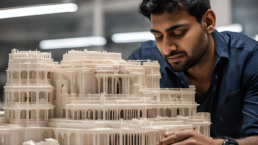How 3D Printing Can Transform Your Architecture Workflow?
The architectural landscape is undergoing a huge change called 3D Printing in Architecture. This change is defined by a confluence of technological advancements, evolving client expectations, and a growing emphasis on sustainability.
The modern architect is challenged to navigate a dynamic environment. While creativity remains paramount, the ability to translate visionary concepts into tangible realities within compressed timelines and budgetary constraints is equally crucial.
We are covering the following topics in the blog below:
Index:
- The Evolving Landscape of Architectural Design
- Challenges Faced by Modern Architects
- 3D Printing: A Revolutionary Tool for Architects
- How Does 3D Printing Work?
- The Advantages of 3D Printing for Architectural Prototyping
- Material Considerations for Architectural 3D Printing
- 3D Printing for Every Stage of the Architectural Workflow
- Security and Confidentiality: Protecting Your Intellectual Property
- Alt Innovate: Your Trusted Partner in 3D Printing for Architecture
Share
The Evolving Landscape of Architectural Design
Gone are the days of static blueprints and laborious physical models. Today’s architects operate in a collaborative ecosystem, leveraging cutting-edge 3D modeling software. This helps them to craft intricate designs into their 3D architectural model. Printing architectural 3D models helps foster open communication with clients and stakeholders.
However, translating these digital creations into physical prototypes for evaluation and feedback has traditionally been a bottleneck. But in this new age, from avant-garde skyscrapers to bespoke residential projects, the architectural landscape is evolving to embrace the limitless possibilities of 3D-printed architecture prototypes.
Partner with a Reliable & Experienced 3D Printing Service Company for Your Prototype
Rapid Prototyping for your next Architectural Project. Leverage the power of 3D Printing in Architecture. Lets create your 3D Architectural Model that impresses your client.
Challenges Faced by Modern Architects: Balancing Creativity with Practicality
Several hurdles can impede the architectural design process:
- Time Constraints: Meeting tight deadlines in a competitive industry can be a constant struggle. Traditional prototyping methods, often time-consuming and labor-intensive, can significantly impact project timelines.
- Communication Gaps: Effectively conveying the nuances of a design concept through 2D drawings can be challenging. Misinterpretations and revisions can lead to delays and client dissatisfaction.
- The High Cost of Traditional Prototyping: Conventional prototyping methods, such as hand-crafted models or CNC machining, can be expensive, particularly for complex designs with intricate details. This can limit design exploration and innovation for architects working with budgetary restrictions.
- Environmental Impact: Traditional prototyping often generates significant waste material, raising concerns about sustainability and responsible design practices.
These challenges highlight the limitations of traditional prototyping methods. The need for a more efficient, cost-effective, and environmentally conscious solution has paved the way for a revolutionary technology: 3D printing.
Check out other blogs by Alt Innovate
3D Printing: A Revolutionary Tool for Architects

3D printing, also known as additive manufacturing, represents a paradigm shift in the architectural design workflow. This technology allows the creation of physical 3D models directly from digital 3D modeling files. By building the model layer by layer using a predetermined printing filament or material, 3D printing offers a plethora of advantages for architects.
AltInnovate is your trusted partner for premium 3D-printed architectural models.
We leverage cutting-edge technology to transform your designs into tangible models. That helps accelerate your workflow and fosters clear communication with clients. Our expertise in 3D printing ensures exceptional results. We bring your visions to life with unmatched precision and efficiency.
Let us help you tell your story better. Get 3D Printing Quote Now!
How Does 3D Printing Work?
At its core, 3D printing is an additive manufacturing process that builds objects layer by layer from digital designs. Using specialized 3D printers and printing filaments, architects can create intricate 3D architectural models with astonishing detail and accuracy.
The process begins with a digital 3D model, created using 3D design software (Autocad, Sketch Up, Rhino, 3DS Max, etc). This model is then sliced into thin horizontal layers, which serve as instructions for the 3D printer.
The 3d printer then deposits successive layers of material—such as plastic, resin, or metal—gradually building up the final object.
Article that might interest: Choosing the right 3D printing material: The ultimate 3D printing material guide
The Advantages of 3D Printing for Architectural Prototyping
By incorporating 3D printing into their design workflows, architects can unlock a range of significant benefits:
1. Rapid Prototyping: Accelerating the Design Process
One of the most transformative advantages of 3D printing for architects is the ability to achieve rapid prototyping. Gone are the days of waiting weeks or even months for physical models.
3D printing allows architects to translate their digital creations into tangible prototypes within a fraction of the time compared to traditional methods. This rapid turnaround time empowers architects to:
- Expedite Design Iterations: The ability to quickly create and iterate on physical models. This facilitates a more agile design process. Architects can experiment with different design variations, receive feedback from clients and collaborators, and refine their concepts with greater efficiency.
- Meet Tight Deadlines: 3D printing helps architects stay ahead of schedule by eliminating prototyping bottlenecks. This is particularly advantageous for projects with compressed timelines, allowing architects to present well-developed design proposals without sacrificing quality.
- The 3D architectural model also helps architectural firms stay innovative and ahead of their competitor.
2. Enhanced Communication Through Tangible 3D Models
The ability to create physical 3D models fosters a more collaborative and effective communication dynamic between architects, clients, and stakeholders. Unlike 2D drawings, which can be challenging to interpret, 3D printed models provide a tangible representation of the design intent. This allows for:
- Bridging the Gap: A 3D-printed physical model allows clients and stakeholders to experience the design more holistically. By interacting with the model, they can gain a deeper understanding of the spatial relationships, aesthetics, and functionality of the design. This leads to fewer misunderstandings and revisions throughout the design process.
- Improved Client Satisfaction: The ability to visualize the design in 3D fosters a deeper level of client engagement and satisfaction. Clients can provide more informed feedback, leading to a more collaborative and successful design outcome.
3. Reducing Costs and Waste with 3D Printing

3D printing offers a cost-effective alternative to traditional prototyping methods. Here’s how:
- Cost-Effective Prototyping: Compared to traditional methods like CNC machining or hand-crafted models, 3D printing can be significantly less expensive.
3D Printing in architecture and construction is a great solution, especially for complex designs with intricate details. This allows architects to explore a wider range of design options without exceeding budgetary constraints.
- Sustainable Design: In an era of increasing environmental awareness, architects are increasingly seeking sustainable design solutions. A solution that minimizes waste and reduces environmental impact.
Traditional prototyping methods often generate significant waste, contributing to environmental degradation. 3D printing offers a more sustainable alternative, allowing architects to explore their designs through minimal waste and modularity.
By embracing 3D printing in architectural and construction projects, architects can contribute to a more sustainable built environment while pushing the boundaries of design innovation.
Might Interest You: 6 Examples of the Largest 3D Printed Buildings Around the World
Material Considerations for Architectural 3D Printing
A wide range of printing materials are available for printing architectural 3D models, each with unique properties to suit specific design requirements. Common materials include:
- Polylactic Acid (PLA): A biodegradable and environmentally friendly material suitable for preliminary models and presentations.
- ABS Plastic: A versatile and cost-effective option for conceptual models and design iterations.
- PET-G: It is non-toxic and odourless, PETG fumes are safe to breathe, so it’s safe to use in 3D printers indoors.
- Resin SLA: Delivers exceptional detail and a smooth surface finish, perfect for high-quality presentation models. It is a great material that can be printed nearly transparently with all the intricate details.
3D Printing for Every Stage of the Architectural Workflow
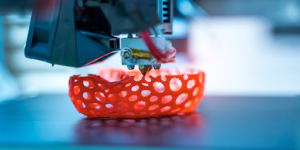
The versatility of 3D printing extends far beyond rapid prototyping. Architects can leverage this technology throughout the entire design workflow, including:
- Initial Design Concepts: 3D printing allows architects to access rapid prototyping. This quickly generates physical models to explore and iterate on initial design ideas. This fosters a more creative and exploratory design environment.
- Client Presentations: High-quality 3D printed models add a powerful visual element to client presentations, enhancing communication and client engagement.
- Construction Planning: 3D-printed models can be used to create detailed physical representations of complex building components, facilitating construction planning and coordination.
Security and Confidentiality: Protecting Your Intellectual Property
When partnering with a 3D printing service provider, architects should prioritize the security and confidentiality of their intellectual property. Look for a company with robust data security protocols and a commitment to protecting your design files.
Alt Innovate: Your Trusted Partner in 3D Printing for Architecture
Alt Innovate understands the unique challenges and opportunities faced by modern architects. We are a leading provider of 3D printing solutions specifically tailored to the needs of the architectural industry.
We offer a comprehensive suite of services designed to streamline your design workflow and elevate your projects:
A Commitment to Quality, Speed, and Sustainability: We utilize state-of-the-art 3D printing technology to deliver high-resolution, high-quality models with exceptional turnaround times. Our commitment to sustainable practices ensures that your 3D-printed models are created with minimal environmental impact.
- AltInnovate makes it easy for architects of all experience levels to integrate 3D printing into their workflows.The potential of 3D printing in architectural design & engineering is limitless. This technology empowers architects to explore complex, innovative, and sustainable designs with unprecedented efficiency and precision. By partnering with a reliable and experienced 3D printing service provider like Alt Innovate, architects can unlock the full potential of 3D printing and transform their design workflows.
Print Now with us! Has this article excited you, but don’t own a 3D Printer yet download a file from one of the CAD file sourcing places and send it to us for your first 3D printed file.
Like what you read? Follow us on all our social media platforms to see new and exciting news and updates we have to share with everyone. This is a great way to stay up-to-date with the latest trends and exciting projects we do here at Alt Innovate.
2024: Getting Started with 3D Printing for Beginners
“Your journey into a community of 3D printing enthusiasts begins now”
Whether you got inspired after watching the Netflix documentary “Print the Legend” or came across the term 3D printing when finding for ways to get your ideas into a physical object. Or if you are a hobbyist with a knack for making DIY drones. Or just took a page from the cool dudes book after seeing their Instagram account post of a machine.
“So cool it made physical objects out of nothing, giving even Houdini a run for his money.”
Share
3D printing technologies has been around for more than three decades. It has been evolving with time into different approaches and technologies using varied forms of 3D printing materials such as Plastics, Resins, etc. They are all focused on one thing, to push the boundaries of development.
Did you know? 3D printing enables you to Rapidly Prototype your idea into a physical object. Right from your desktop to your table. This process is referred as “Rapid Prototyping” in the industry.
So, Will we call 3D printing a manufacturing tool or a prototyping tool?
How about both ! 3D Printing has enabled companies to produce complex geometries of parts. Some of which earlier wouldn’t have been possible with the commonly available manufacturing processes.
It is a tool that now empowers designers, enthusiasts & makers to test their ideas, the only limit being their imagination.
There are many guides available that talk about 3D Printing. Our focus is to explain how to get into the 3D printing industry and provide you with paths for further exploration.
By the end of this article, you will have a clear understanding of how to begin with 3D Printing and where to go next. So whether you want to just get familiar with the process of 3D Printing or actually get your hands on a 3D Printer and start tinkering, read below and empower yourself.
PART 1 : Getting Familiar with the Tool
Hello World of 3D Printing
As 3D printing generally is a broader term, we are going to focus mainly on the most widely used 3D Printing technology known as Fused Deposition Modelling or “FDM”, a term trademarked by Stratasys also industrially known as Fused Filament Fabrication or “FFF”. FDM/ FFF 3D Printers are generally where many beginners start and our advice for you would be to start here as well and then as with experience branch along to other technologies.
Additive Manufacturing, a more widely accepted term for the process that FDM 3D printers use, is simply a process where a “tool” such as the FDM 3D printer lays down layers of melted plastics (Filament) one on top of the other, thus converting a 2D Dimensional outline into a 3D dimensional object. Compared to other manufacturing processes which use subtractive methods such as CNC machines where materials such as Aluminium are chipped away layer by layer to create the desired shape.
To further understand additive manufacturing, let’s look at the Tool in detail. A 3D printer works on the principle of XYZ coordinate systems where XY is your Left-Right, Front-Back movements and Z is your Up-Down movement.
_______________________________________________________________________________________________
Article that might interest you: Choosing the right 3D printing material: The ultimate 3D printing material guide
_______________________________________________________________________________________________
The parts include thus are:

Build Surface which is the surface on which the molten filament is laid down. The build surface is heated to stick the filament to the surface. We do this in order to create a strong foundation for the printing process.
“Don’t worry this does not stick your prints on it permanently and prints can be easily pushed away from it”.
The build surface is generally operated at a temperature of 60-100 degrees. This depends on the material and surface. Commonly used surfaces are glass beds, aluminium beds.
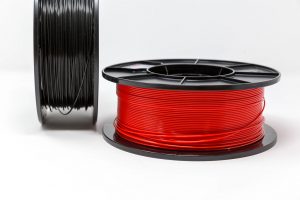
Filament, which is the raw material used to convert your CAD file into a 3-dimensional physical object, can be made up of materials such as PLA, ABS, PET or PET-G, TPU, NYLON and more. You can learn more about the materials from our materials guide.
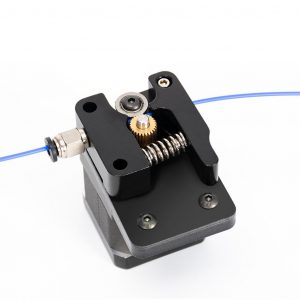
Extruder is one of the crucial parts of the 3D Printer, it is used to push the filament into the hotend in a controlled manner to make sure the exact amount of filament is pushed through the nozzle at any given point to maintain print consistency and flow of the molten material. It is controlled via a stepper motor or servo motor and is continuous in action during a printing process.

Hot-end can be a decisive factor of the printer; it is a core component which enables you to print various materials. Hot Ends are purpose built and each with their own limitations, they can reach a very high temperature as high as 450 degrees to help you print materials such as Nylon.
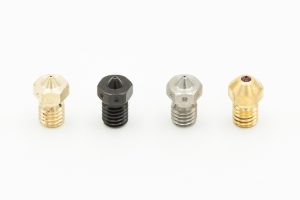
Nozzle apart from being the component that helps put down the filament in the desired shape, also focuses on bringing out the quality of your print. Smaller nozzles allow you to print in finner layer lines bringing out more improved quality of your print. Larger nozzles lay down thicker layer lines useful with larger component sizes.
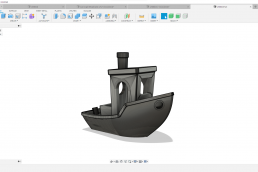
PART 2: PREPARING THE CAD FILE
Now that we have said our hello to the 3D Printer, let’s now see the process in action. The process can be broken down into two steps one is the Digital aspect and the 2nd being the Print in itself. Let’s begin with generating our 3D Digital file.
Generating the CAD File:
A 3D Printer relies on humans to tell it what it needs to print. Maybe in the future, we might have such technologies. Technologies that would be able to decide what to print as per needs. Automatically it will print and process it for us.
Until we attain this future scenario let’s stick with DIY. Developing what to print with a better understanding of our requirements.
The process begins with an idea. Then translate that idea into a 3-dimensional model, CAD or Computer Aided Design model. To generate a CAD design you would first need a 2-dimensional blueprint. After which we need a sketch to help you visualize. We need to visualise the different orthographic faces of your 3-dimensional object.
Then we use specialized 3D modeling softwares. Software such as Autodesk Fusion 360 or Rhino or Blender to create a CAD model. CAD model is a step before printing. It helps you visualize your idea virtually and make changes. The CAD model is also developed true to scale.
Sourcing CAD FILES:
Alternatively, maybe you are not a 3D Modeller (a person who makes CAD models). Yet you want to 3D print some props. May be from your favourite movie or gifts for family members.
Example, lets say IPL is on and your best friend is a big fan of M.S. Dhoni, you can come to 3D Printing Company like Alt Innovate. They will create the design and get 3D printed Model for you. With Alt Innovate get your ideas to reality.
If you wish to do a DIY, then we suggest you to pick up a 3D modelling course over your next holiday to help you with the 3D Printing process, a good starting point is to source 3D CAD files.
Thankfully, 3D print as a whole is a huge community. There are many open source platforms that host of 3D printing files. These files shared by 3D printing enthusiasts all over the world. You can download and convert into G-Code and begin printing. We have listed the best ones below:
- Thingiverse – www.thingiverse.com
- Cults3D
- MyMiniFactory
- Prusa Research
- CGTrader
- Grab Cad
What is a G-Code?
Just as computers use assembly language to function. Assembly Language is basically a set of 1’s & 0’s binary. This is used to create a set of instructions. G-Code is machine code, a set of instructions that 3D printers use.
We will learn more on how to set up a G-Code in Part 3. The important bit is to learn that G-codes are a set of instructions for your 3D Printer.
Unlike us humans machines don’t read alphabets. They read G-Codes which tells them when to move and how fast to move. It also guides which axis should it move in. It contains the layer-by-layer instructions for the
- printer
- Speed
- Acceleration
- when to start
- when to stop
- height of the layer
And countless other settings which helps your 3D Printer to print your CAD Model.
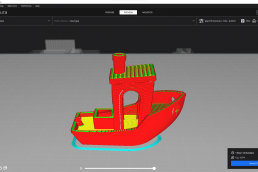
PART 3: PREPARING TO PRINT
Step 1: Saving your CAD file
To print your first CAD model, you need to save your CAD Model in the file format: STL. STL files are readable via the majority of the popular available slicing softwares in the market. Let’s learn about slicing softwares in Step 2.
Step 2: Let’s make your first G-Code
As we learnt earlier G-Code is machine-executable instructions. G-codes are prepared with the help of a slicing software. Slicing software is nothing but the software used to cut your CAD model. CAD Model is cut into fine individual layers. They are then executed by your 3D Printer. Printing one layer at a time in an additive manner.
To slice your CAD model, import your newly saved STL file in popular slicing software. Software such as CURA, PRUSA SLICER, Simplify 3D. These are some beginner friendly tools. You are then introduced to a host of settings. These settings can be further fine tuned to your need. Some commonly adapted settings are:
Layer Height: The lower the value (Ex: 0.1 layer height) more detailed the print. This would be at an expense of a higher print time. The higher the value (Ex: 0.24 or even 0.28) the more you lose resolution. But it decreases your overall print time.
Infill percentage/ Type: This setting is used to impact the strength of your print. A higher infill value will not only increase the weight of your print but also enhance the strength. The lower infill value will reduce the overall strength. This saves you some weight and print time.
Print Speed: Print speed is basically nothing but how fast you want your print to go. A nominal value of 50-60 mm/s is set at default. For a novice user we would recommend not to fiddle around much. Until you have spent some time printing. Then slowly experiment with the print settings.
Support: A crucial setting when printing objects with Overhangs. By now I am sure you have understood the additive manufacturing process. So you know printers need a base layer to print the next layer. It won’t print in mid-air. Hence, when you have prints with overhangs you need to use supports. These supports act as a support to the layer hanging away from the base. Thus, enabling it to be printed without any issue.
You can learn more about these in our 3D Printer Slicing guide.
Next Steps
Once you have adjusted the settings well. Lets slice the file and prepare a machine executable G-Code. Hit the magic button on your slicing software which would read something like “Slice Now”. Now wait for the slicing to be completed.
Once the slicing is complete the software will show you the print time. Layer dissection and an option to transfer your G-Code file into a readable memory drive.
You can now connect your memory card which came with your printer to your desktop or laptop. This will allow you to transfer the G-Code file to it. Next up let’s print our first file.
*There could be instances where your printer size is smaller compared to your model and won’t accommodate the entire model in one print, a good practice is to bring your model apart in smaller pieces and weld or glue the pieces together later.

PART 4: LET’S PRINT
Now that we have completed step 2, and prepared our Model, sliced it and generated the G-Code, it’s now time we go ahead and Print.
Prep for Printing
Before we hit the “Start Print” button we need to prep our printer to make sure we achieve the best print output, some of these are repetitive tasks and some tasks are more related to your printer management.
As for this guide, we are using FDM machines, we will explain the prep portion by using the most generally purposed used filament “PLA”. PLA is most commonly used for quick prototyping as an initial test before making a final print in say ABS, PET/ PET-G, or something else.
Step 1:
Let’s turn on our machines and depending on the machine you are using navigate to the Control setting, you should find an option with the Label “Temperature” in there. Now we begin to prime our Hotend to 200c degree, next within the same menu you should find the option to heat up your build surface, set it at 60 c degrees. These are generic settings used with most PLA Filaments.
*Please note that Hot End Temperature and Build Surface(Bed) temperature would change based on what kind of filament you are using, many manufacturers have their recommended filament settings mentioned on their packaging, so do make sure to check that and follow until you have gained enough experience tweak the settings by yourself.
Step 2:
While your hot end is getting primed and reaching the set temperature let’s go ahead and load the filament into the machine. Get the filament out of the box and find the open end. Make sure to not let the filament go lose from the spool (Spool is on which the filament is wrapped around).
Now find the open end and using a cutter tool, probably provided with your 3D Printer tool kit. Cut the end in an angle, this will help the filament to pass through the extruder much more easily.
Enter the filament through the extruder open end and make it pass through to the coupler all the way into the hot end, (pro-tip you can also pull the extruder lever and push the filament all the way in or turn the knob on the extruder), once done, mount the spool on the spool holder. When the hot-end reaches its set temperature you would soon see the molten PLA ooze out of the Nozzle.
*A hot tip for everyone, based on a personal experience, once you cut the filament in an angle before putting it through the extruder, twist it slightly so when the filament passes through it aligns with the coupler end of the extruder.
Step 3:
Give your bed a wipe, it’s a good practice to give your bed a clean wipe either with soap water, or surface cleaner. Just spray some onto the build surface and wipe it away with a cotton cloth or paper towels. At this point, depending on the print surface if it’s coarse or smooth you might want to put an adhesive on your build surface.
Generally, for a small size print on a coarse surface, you should do just fine without an adhesive. But it is a good practice to use an adhesive just to be safe with larger prints or longer duration prints. This keeps the print stuck to the bed. It will also help you in case of a power failure your bed loses temperature the adhesive will help with keeping it in place.
Step 4:
Let’s go ahead and print. Insert the Memory Card in which you just loaded your G-Code and navigate to the Print section in your menu. Discover the file name with the G-Code, and select.
Now all you need to do is stand back and watch the printer do its magic.
Once the print begins there is nothing much you can do. But here are some of our Pro-Tips
- Make sure to monitor the very first layer of your print, this is the foundation layer and makes or breaks your print.
- Are the lines faint? Could be your nozzle is too close to the bed, change the offset.
- Signs to look for, is your printer under-extruding / over-extruding? You might find gaps between your layer lines or blobs on your print
- Constantly monitor to see if your print is running smooth, if you see your nozzle moving but it’s in the air and nothing is coming out of the nozzle. You have hit disaster and your print has failed. Stop the print as it could be a nozzle clog or failure at the extruder end.
You can read more on common 3D Print failures and how to correct them here:
Now, hoping everything went smooth and your print is complete.
Congratulations you just 3D Printed your first. Your life is just about to get a whole lot more interesting. You will soon find your home, workspace filling up with 3D Printed parts, Headphone holders, Check? Phone stand, Check? Custom keychains? Possibilities are endless.
Check Out the Top 10 things to 3D Print: Workspace Management Edition
Welcome to 3D Printing
If you have stuck with us all the way to the end here are some additional tips for you to follow and carry into your 3D Printing process.
- If you find yourself to be printing occasionally, moisture is your enemy! You will soon find your filaments going bad. One of the reasons your print fails is due to poor storage of filament and hence, we advise you to store your filament in a sealed airtight container when not in use.
- Make sure to keep your workspace neat and tidy before and after every print, and keep your tools organized. Trust Us, this will keep you hooked to 3D Printing always.
- Make sure if your printer uses a belt-driven system that you check your bed tension periodically. Too loose and your prints fail, too tight and again your resolution is very poor. Make sure when you tighten your belt you don’t over-tighten it, a nice way to check is to pull down on your belt like strumming a guitar string, a slight vibration is a strong indication of a nicely tightened belt.
- Make sure to check your bed level every 2 weeks or after every 40-60 hours of print for a great print result.
- After every 100 hrs of printing make sure to check all your screws and nuts, continuous use can affect your printer, as well as vibrations from printing, can put stress on the nuts and bolts. It is a good practice to also replace your nozzle at this point as it may wear out. We recommend these as standard brass nozzles are cheap and something you shouldn’t shy away from replacing.
Additionally, now that you have gotten yourself into the 3D printing habit. There will be times when the Raw output of 3D printed parts are not complete for your use and you might want to paint them.
Follow these post procedures steps to attain an even greater quality of print. A quick hack if you are sure you are going to paint your parts, print at a slightly higher layer height to speed up the printing process.
POST-PROCESSING
- Removal of Supports: Many times your prints might use supports as we learned during the slicing process. When your prints are complete, supports are attached to them. They are generally easy to remove. A slight push of your thumb will do the trick or use a “minus” head screwdriver to break the joints apart.
- Sanding: before you proceed with painting, smoothen out those layer lines with a 220-grade sandpaper. Once smooth you can fill the holes and imperfections with the help of putty and sanding a bit more.
- Primer: A good practice would be to primer it and smoothen it out with a 600-800 grade sandpaper. If you need an even higher grade of finish, prime it again and sand with 1000-2000 grit sandpaper. Now we are ready to print. Repeat step 2: putty and sand as and where needed.
- Paint: Get your mask on, clean your print make sure it is dry, mix the colour of your choice and go ahead and print
- Lacquer: You can choose lacquer to protect your painted surface.
Hope the above guide is helpful and you have learned a lot from this, if you did, share this with people who you think might benefit from this.
Print Now with us! Has this article excited you, but don’t own a 3D Printer yet download a file from one of the CAD file sourcing places and send it to us for your first 3D printed file.
Like what you read? Follow us on all our social media platforms to see new and exciting news and updates we have to share with everyone. This is a great way to stay up-to-date with the latest trends and exciting projects we do here at Alt Innovate.
Top 10 things to 3D Print: Fidget Toys Edition
Welcome to Alt Innovate, each month we bring you Top 10 things you can 3D print or get 3D printed for yourself. The “Top 10 things series” is focused on showing different aspects of 3D printing such as Usefulness, Effectiveness, use of 3D printing in Education, day-to-day life, arts and crafts and more.

Theme:
For the month of September 2022, our posts revolved around the theme of “Fidget Toys”.
Let’s Explore Fidget Toys
Have you ever found yourself bored? Stressed? Anxious?
Fidget toys are a great way to focus and relieve stress and anxiety. They are also useful tools when trying to improve your mental focus and concentration. Providing comfort, and mental focus, and helping elevate the symptoms of stress and anxiety.
Let’s look at some of the ways that 3d printed fidget toys help you with the same!
(*the above paragraph was created using Ai)
Checkout our list of cool “Fidget Toys” below, some of the products are designed by other creators and we have correctly attributed and shared their link if you want to check it out.
Let’s get started!
1. Gear Shift Fidget: This one is for the gear heads out there. Miss Shifting through the gears in your car? Get this cool fidget toy and cycle through the gears as much as you wish. The design is made by: Michal Fanta. You can get it 3D Printed at Alt Innovate.
2. Rotary Engine Spinner: Another one for the gear heads, but anyone can enjoy this. A cool Fidget spinner with engine blocks on it. This Fidget spinner is designed by: Michal Fanta.
Get yours 3D Printed with us at Alt Innovate.
3. Clicker: Love clicky wheels? Get this cool fidget toy with a satisfying clicky gear. Happy Clicking! This fidget clicker is designed by: BaGooN. Get yourself a 3D Printed fidget clicker at Alt Innovate.
4. Macro jack: This little fidgety jack might not be able to lift much but it’s surely satisfying to gear it up and down. The design is made by: Strider Varun. You can get it 3D Printed at Alt Innovate.
5. Arc flipper: This fidget toy is a fun handheld game. Flip the flippers and watch the bib bounce back and forth. This arc flipper is designed by SteveJohnsen. Get yours 3D Printed with us at Alt Innovate.
6. Bistable fidget button: This fun fidget toy combines the satisfaction of a button press and a lever squeeze in one palm-sized fidget. This fidget is designed by: 6 safpep. Get yourself a 3D Printed fidget button at Alt Innovate.
7. Geared Fidget toy: There is something so satisfying about just watching this fidget toy converting the linear motion of your fingers, making the flag rotate and back and forth. This toy was designed by mmOne. You can get it 3D Printed at Alt Innovate.
8. Knocker: Enjoy the knocking sound of this 3d printer knocker fidget. (warning: keep away from children). This knocker was designed by TN 3D-Objekte. You can get it 3D Printed at Alt Innovate.
9. Clicker: Entertain your fidgety fingers with this clicker making a nice click sound. This Clicker is designed by SHR3D.eu. You can get it 3D Printed at Alt Innovate.
10. Gear Fidget toy: This geared roller has a really satisfying feel when you roll it in your hands. This gear fidget is designed by Whity
*Check out these products in action on our Instagram account.
Summing up,
This concludes our Top 10 things to 3D print for the month of September, we hope you enjoy 3D printing & playing with these products as much as we did. You can get these fidget toys 3D Printed at Alt Innovate.
Let us know what’s your favourite product, have any suggestions for us or themes in mind you would want to see, reach out to us with the link below and our team will get back to you!
Print Now with us! Has this article excited you, but don’t own a 3D Printer yet download a file from one of the CAD file sourcing places and send it to us for your first 3D printed file.
——————————————————————————————
Like what you read? Follow us on all our social media platforms to see new and exciting news and updates we have to share with everyone. This is a great way to stay up-to-date with the latest trends and exciting projects we do here at Alt Innovate.
Top 10 things to 3D Print: Upcycling Edition
Welcome to Alt Innovate, each month we bring you Top 10 things you can 3D print or get 3D printed for yourself. The “Top 10 things series” is focused on showing different aspects of 3D printing such as Usefulness, Effectiveness, use of 3D printing in Education, day-to-day life, arts and crafts and more.
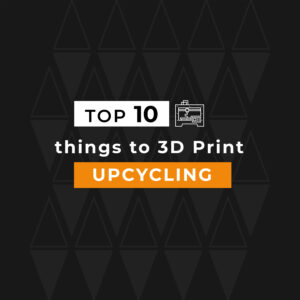 Theme:
Theme:
For the month of July 2022, our posts revolved around the theme of “Upcycling”. We focused on how you can upcycle old items, scrapped products lying around your home and give it a new life. Have that plastic bag or a soda bottle lying around your house which you don’t have any use for and don’t want to scrap either. We might have just the perfect solution for you.
Let’s Explore Upcycling
Firstly, what is Upcycling and why should you practise in your daily life? Upcycling is the process of converting waste materials into new materials or products of better quality. Upcycling is fun and at the same time it also helps solve plastic pollution by enabling re-use of a lot of plastic products. It also saves money as you’re reusing what you already have. And lastly, it’s so much fun!
(*the above paragraph was created using Ai)
Checkout our list of cool upcycled products below, some of the products are designed by other creators and we have correctly attributed and shared their link if you want to check it out.
Let’s get started!
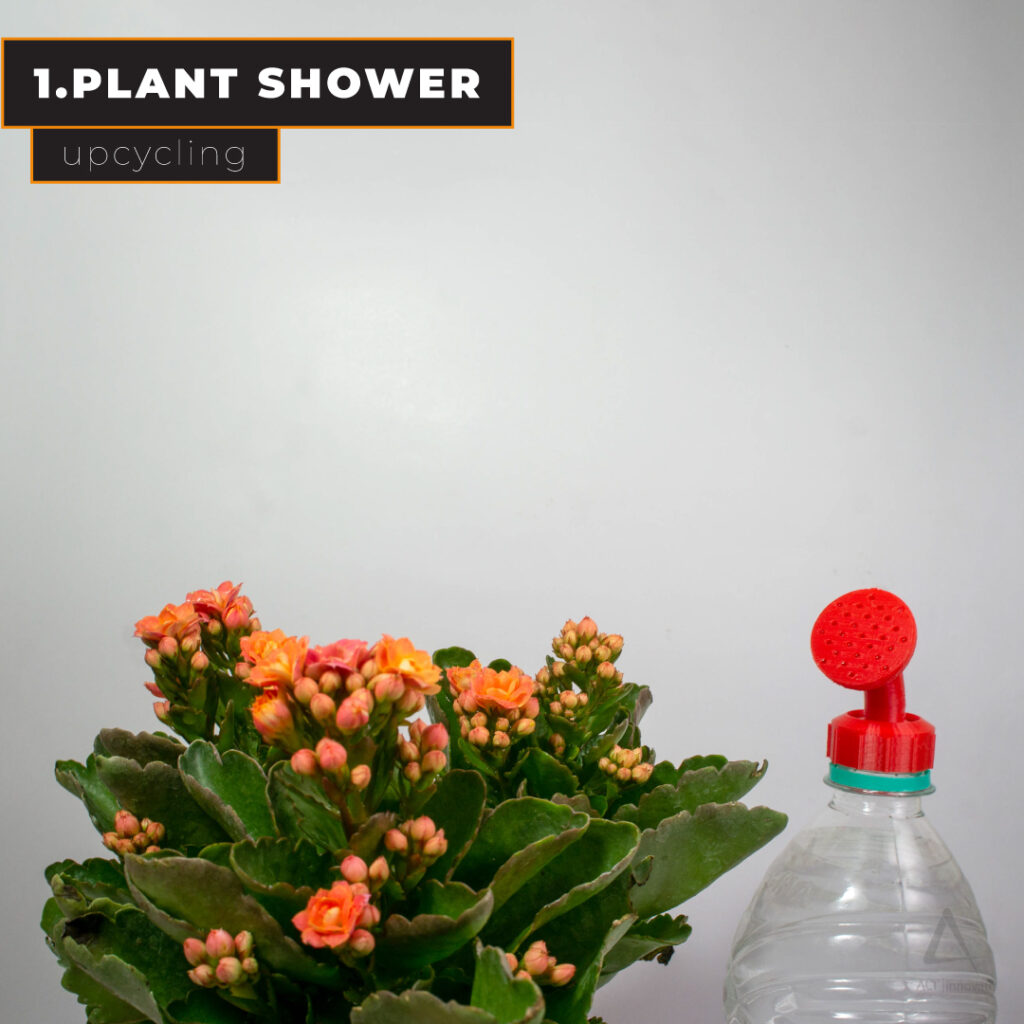
- Plant Shower: Most of us have a regular intake of plastic bottles in the form of soda bottles or packaged drinking water. You can use any regular soda / water bottle and convert them into usable plant watering bottles. The plant shower is designed by: Vijit

- Spice Dispenser: For the energy drink fans out there, you can upcycle used old soda cans or other similar objects and use them as spice dispensers. The spice dispenser is designed by: Mathis
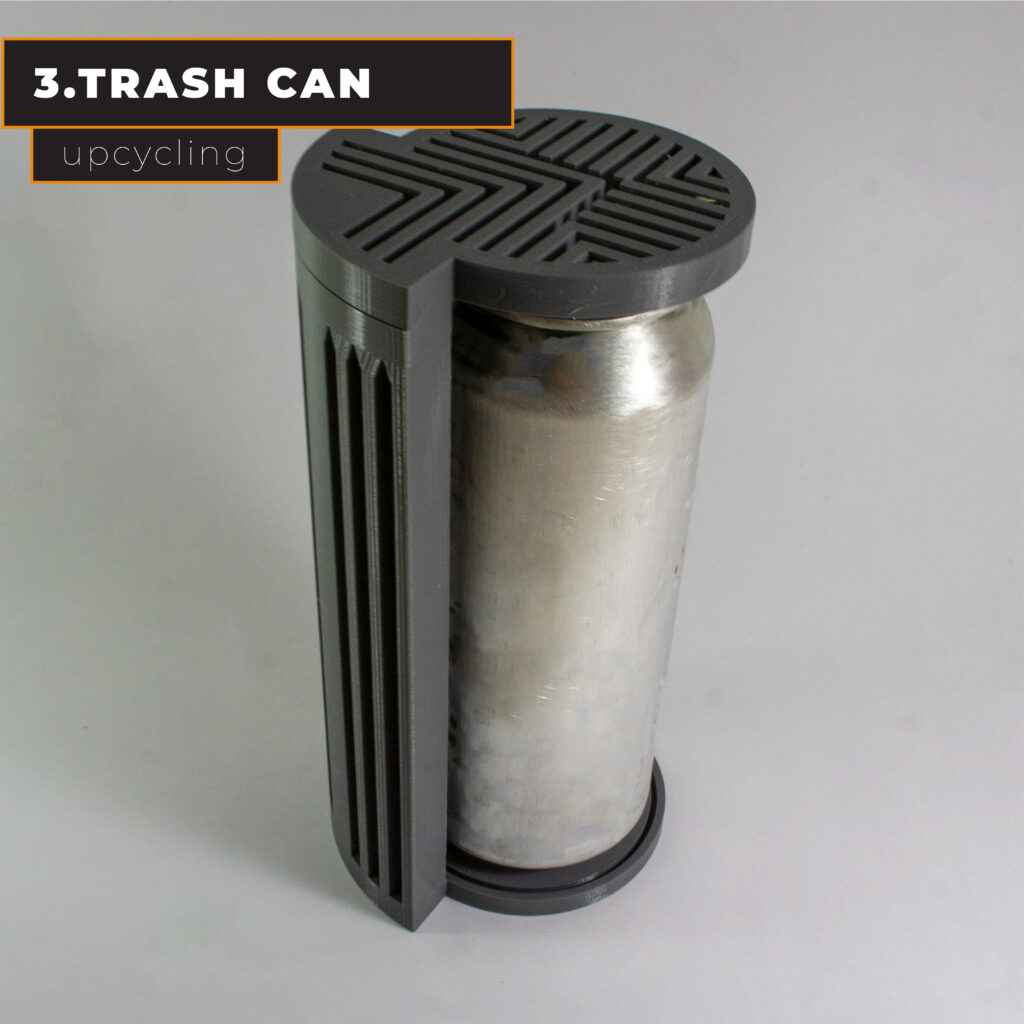
- Table Top Trash Can: Another one for upcycling cans. Use any regular soda cans and convert them into usable Table Top Trash cans to tidy up your workspace. Quick Tip: You can also use your Starbucks Cups. The trash can is designed by: AthenaBen
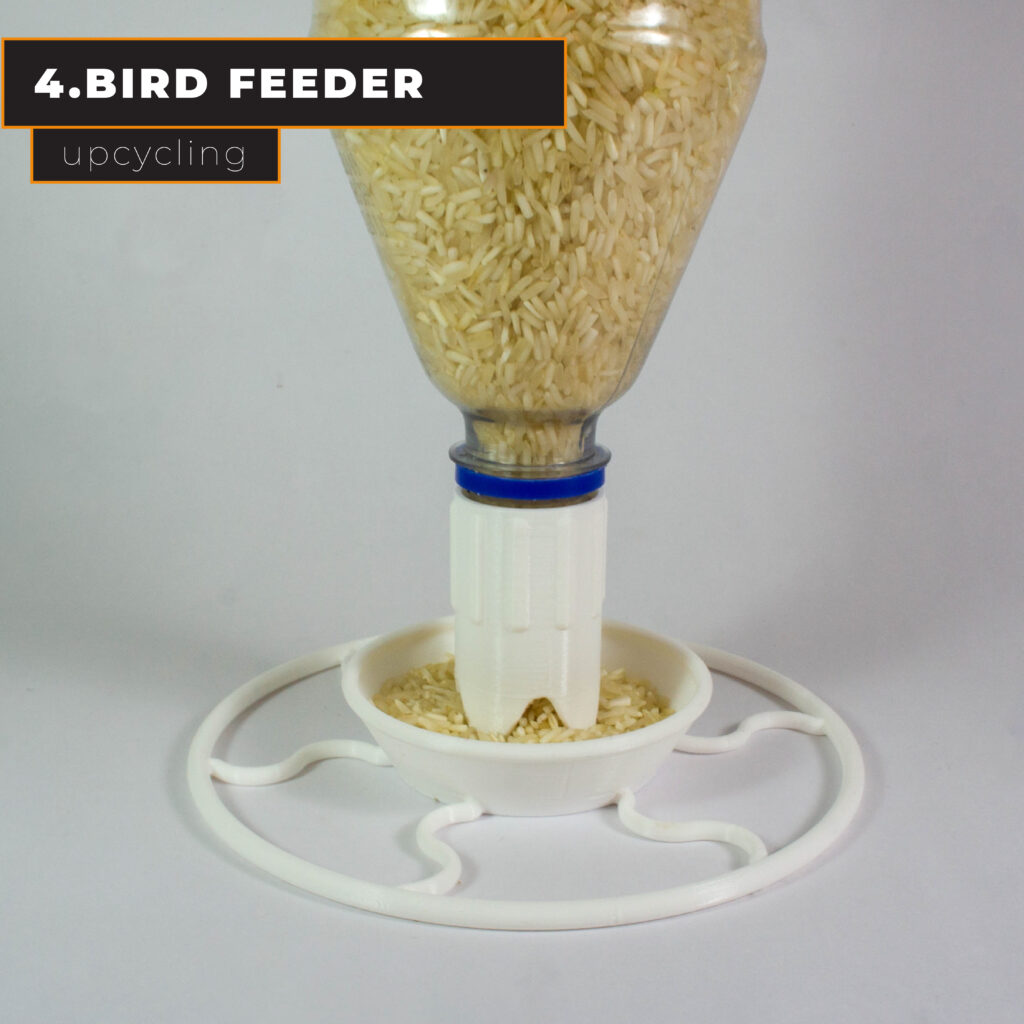
- Bird Feeder: This one apart from saving plastic bottles from ending up in trash, also provide some help to our little winged friends. Upcycle your old soda bottles or other similar objects and use them as Feeder for birds. Warning: Your space will be filled with cute birds. The bird feeder is designed by: Gazorpa
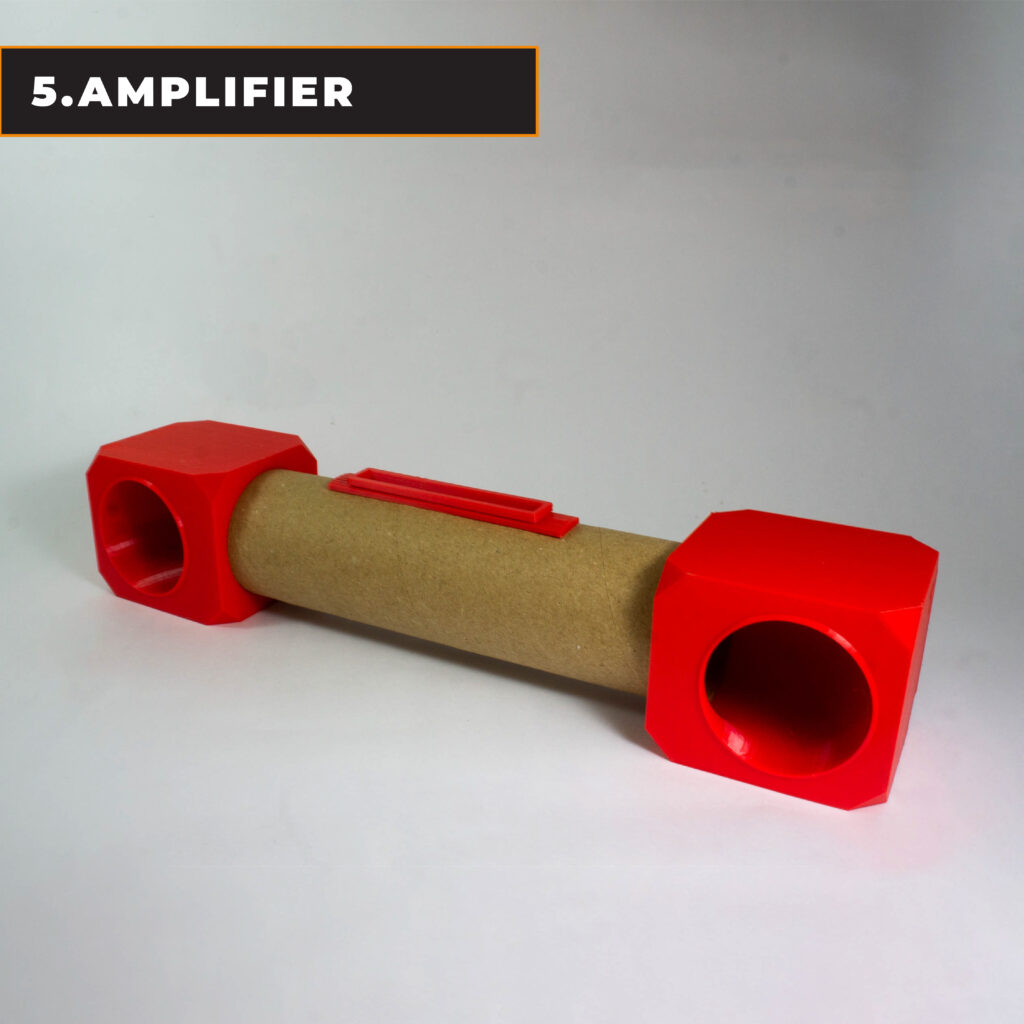
- Amplifier: This is a really cool one. You can convert your used tissue roll cardboard tubes into a stunning sound system, with 3 quick 3D printed parts creating your own sound amplifier. Now Amplify your music without using electricity. The Amplifier is designed by: Daniel Abrantes
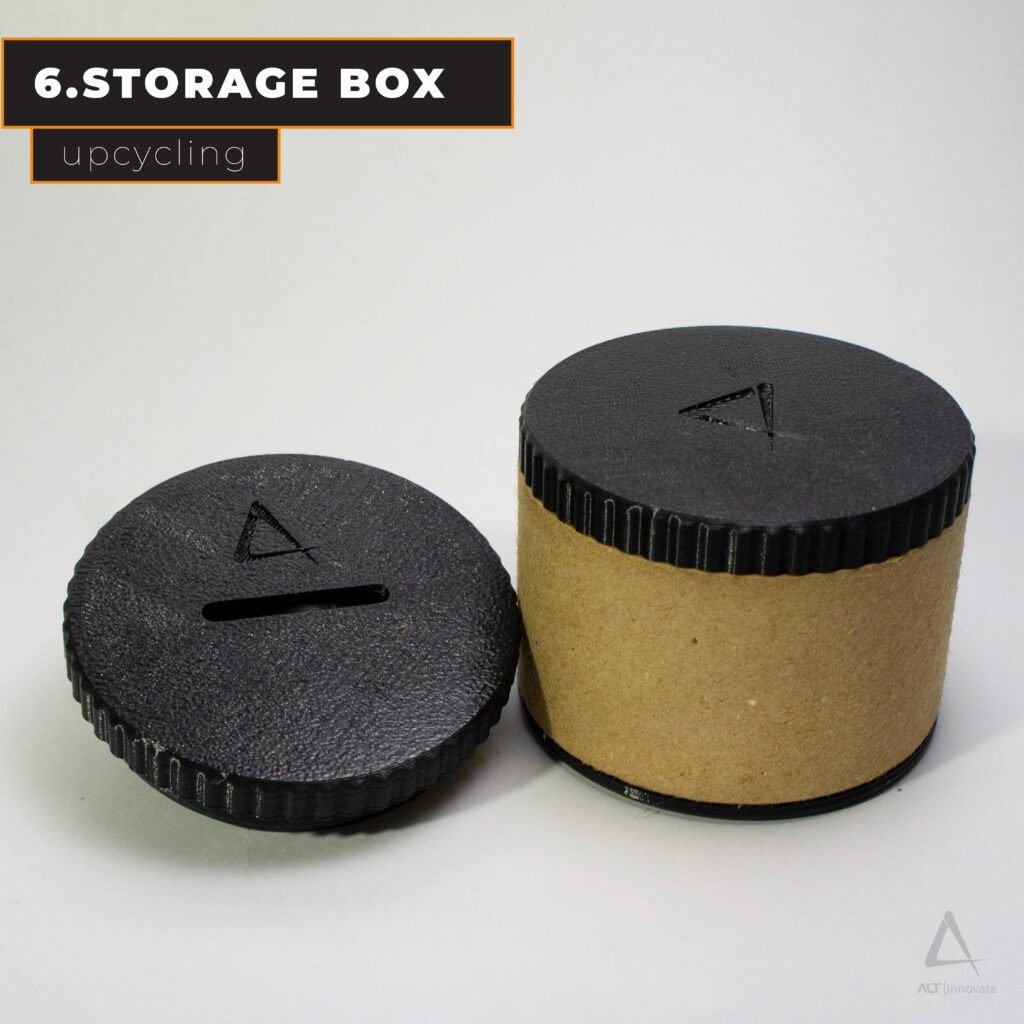
- Cardboard Tube Storage Box: You can convert your completed packing tape cardboard tubes into small storage containers. Use it to store anything from Jewellery to a makeshift piggy bank. The storage box idea is inspired from Dominik Císař design found on myminifactory. We have remixed the design to match our preferences. Design can be found here: Dominik Císař

- Pencil Shaving Bottle Bin: Still some soda bottles left? Upcycle your old soda bottles or other similar objects and use them as a bin for your pencil shavings. No more dirty desks. The design for the Pencil is inspired from: TOPE designs. And remixed by us to match our preferences. Tope designs can be found here: TOPE Designs
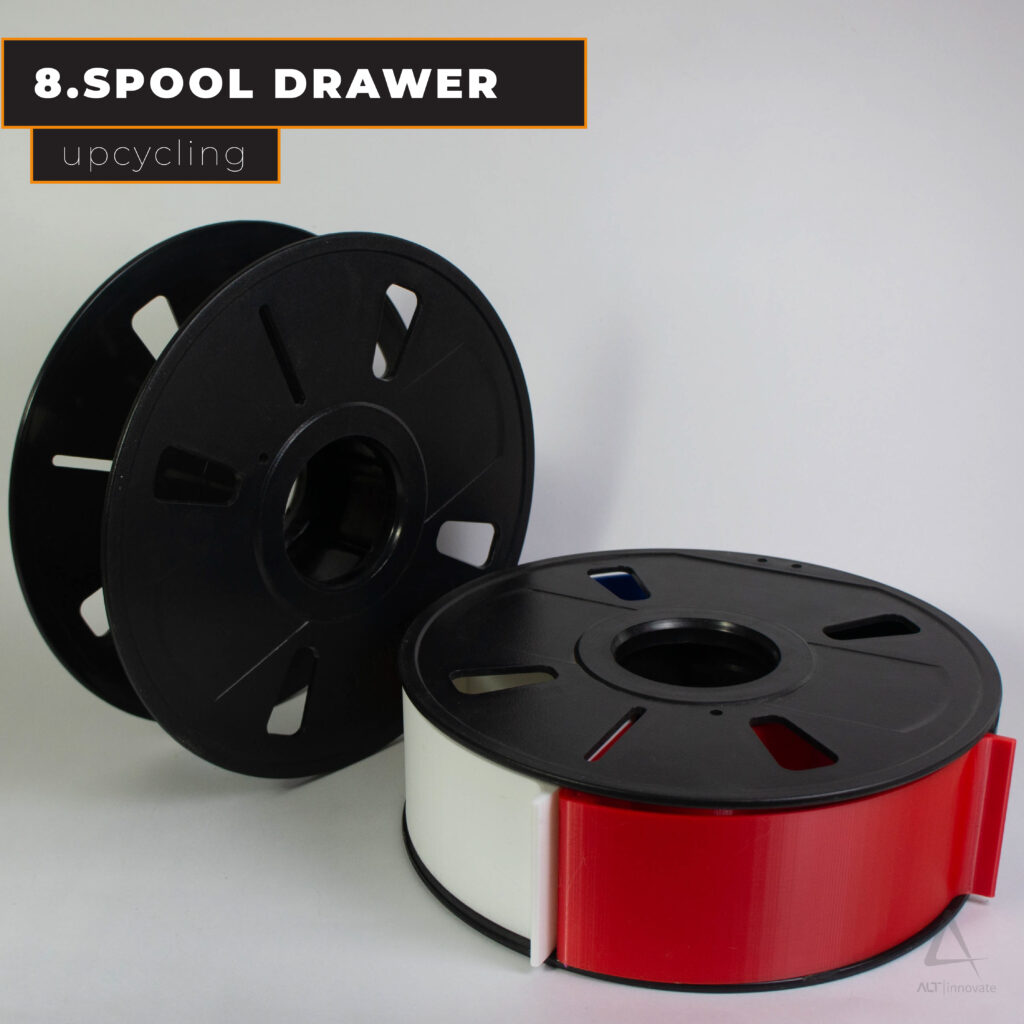
- Spool Drawer: This one is focused on 3D printer users, now convert your completed spool holders and convert them into storage units to hold spare parts for your 3D Printer. The spool drawer is designed by: That_Jamie_S_Guy
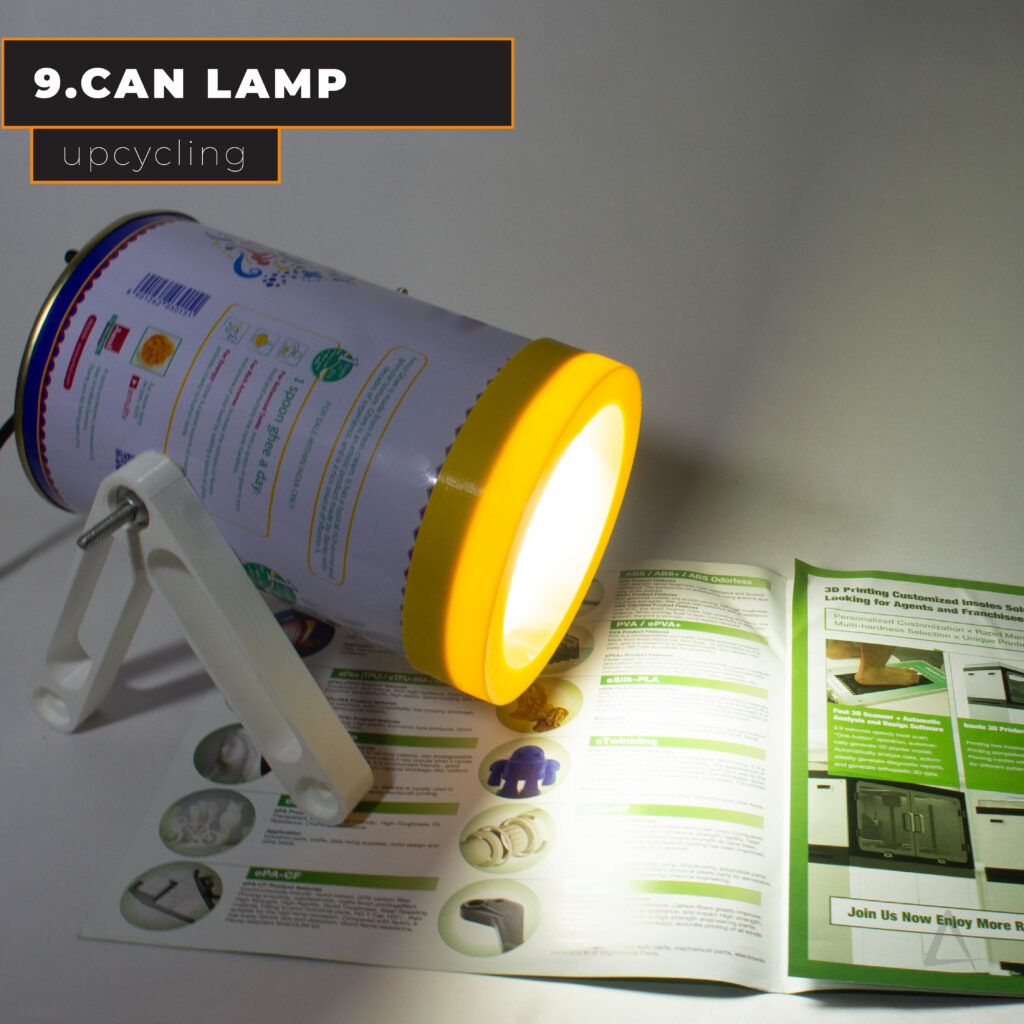
- Can Lamp: You can also convert some of the bigger cans into creating your very own desk lamps. These tiny desk lamps are perfect for regular use from reading, writing to lighting up the corners of the room. The tiny Can lamp is designed by: z-upcycling
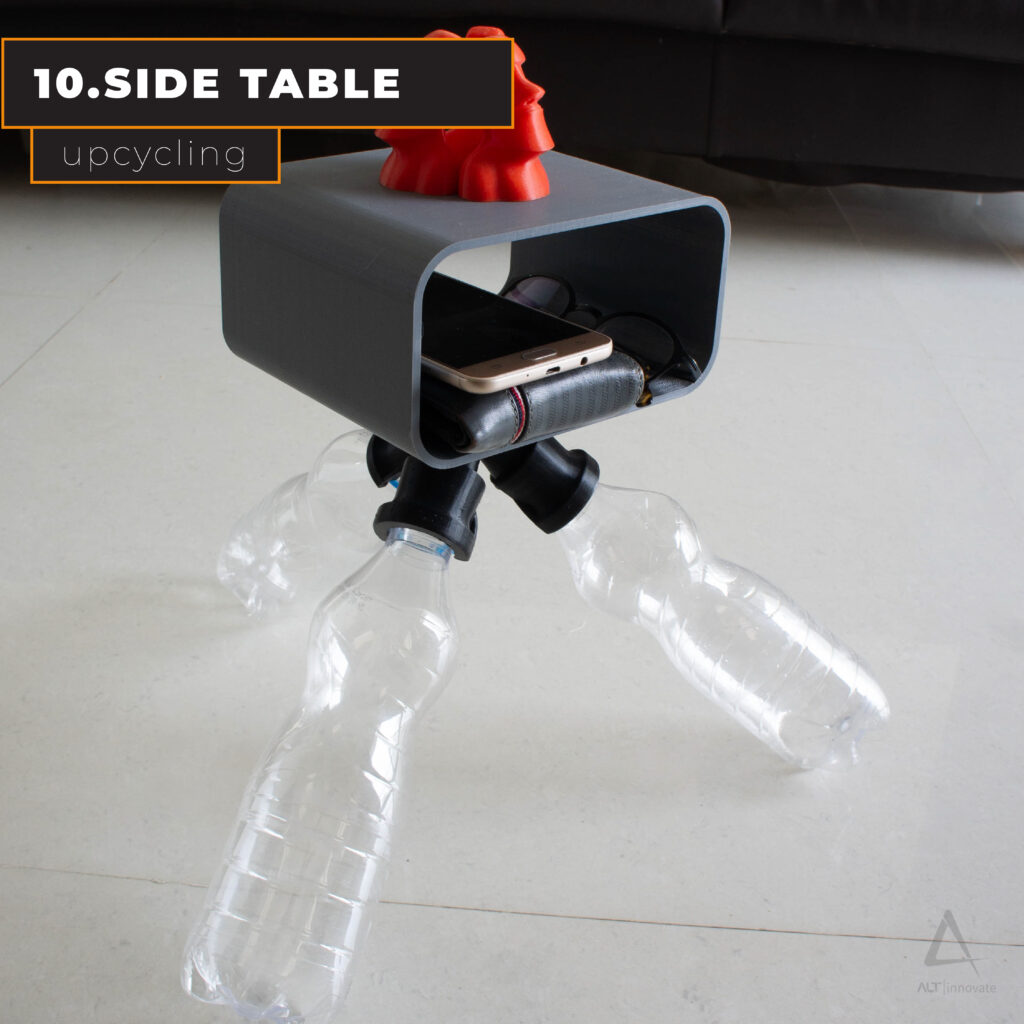
- Side Table: you can upcycle unused plastic bottles to create your own little side table. The side table can easily take weight of upto 1kgs and other light objects. The side table is designed by: Richard
*Check out these products in action on our Instagram account.
Summing up,
This concludes our Top 10 things to 3D print for the month of July, we hope you enjoy 3D printing these products as much as we did.
P.s. Our followers loved the Bag Spout and many reached out to us for 3D printing the same. Artists loved the Pencil shaving bottle bin and side table is every bachelors dream on a budget. Let us know what’s your favourite product, have any suggestions for us or themes in mind you would want to see, reach out to us with the link below and our team will get back to you!
Print Now with us! Has this article excited you, but don’t own a 3D Printer yet download a file from one of the CAD file sourcing places and send it to us for your first 3D printed file.
——————————————————————————————
Like what you read? Follow us on all our social media platforms to see new and exciting news and updates we have to share with everyone. This is a great way to stay up-to-date with the latest trends and exciting projects we do here at Alt Innovate.
